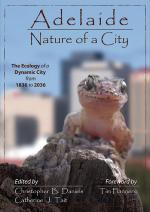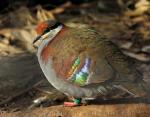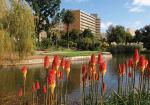The nature of our city - and how you can help
 Environmental Biology Environmental Biology
Adelaide Nature of a City: The Ecology of a Dynamic City from 1836 to 2036 is the history of Adelaide as a habitat, a story that is unique because of our position as a city that was located by its founders on the most fertile, biodiverse land in the state. Featuring contributions by 75 authors from virtually all the major scientific organisations in the state, the book has been produced by BioCity, the environmental research, education and communication centre based at the University of Adelaide. Dr Chris Daniels, Associate Professor and Senior Research Fellow in Environmental Biology in the University's School of Earth and Environmental Sciences is one of the book's two editors. The other is fellow BioCity researcher Ms Catherine Tait. "We are an extremely lucky city, but we could lose it all," Dr Daniels said.
"We're not doing enough to maintain the habitat we are fortunate enough to live in. If we don't want to lose our natural biodiversity, we are going to have to do some work to keep it." The book outlines the natural history of Adelaide and gives detailed descriptions of native and introduced species, the way the city was planned, the way it has grown, and its potential - for better or worse. According to Dr Daniels, every house in Adelaide should have a copy of the book. "What do you know about the land your house is on? This book enables everyone in Adelaide to read about their house, their suburb, the history of the area, the nature of the landscape," he said. "Most mistakes result from a lack of information. This book tells you all about the land you're living on. If you are on a floodplain, you are going to get flooded, sooner or later. It might only happen once in a hundred years and it is highly likely there is infrastructure to protect you, but you need to know about that. "This sort of information also helps people to form a connection with the land and its history. Do not view your house and its yard as an investment or something that is yours and yours alone. It is part of the community. You have a responsibility as part of the community to know about your environment and to act within it. "What we're saying here is not that your garden has to be native. If you like roses, that's great, that's part of the culture we live in. This book shows the bigger picture." Adelaide Nature of a City outlines native and introduced species across Adelaide and also guides readers as to which are pests and which should be encouraged. "I like to say 'express yourself in the front yard, but in the backyard, do something for the birds, lizards and butterflies'," Dr Daniels said. "It is great that we are all starting to think green, but it needs to be understood in terms broader than only electricity and water usage. To be truly green there must also be emphasis on habitat. It's about trees and animals, not just power and water." Story by Lisa Reid
Adelaide Nature of a City: The Ecology of a Dynamic City from 1836 to 2036 will be launched on Tuesday, November 22. All proceeds from sales of the book will go back into BioCity. To find out more, read sample chapters, or download an order form, visit the BioCity website.
|









